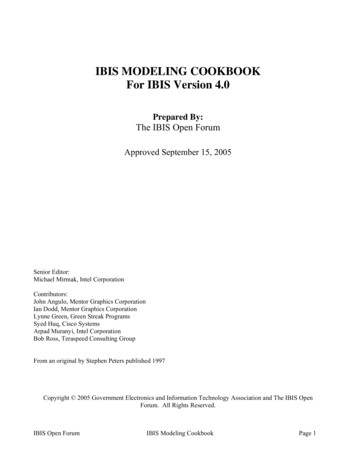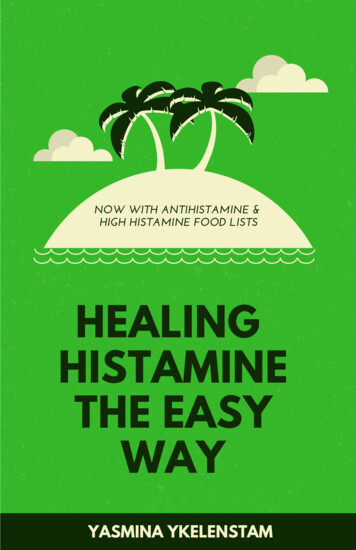
Transcription
The Data Engineering CookbookMastering The Plumbing Of Data ScienceAndreas KretzMay 18, 2019v1.1
ContentsIIntroduction91 How To Use This Cookbook102 Data Engineer vs Data Scientists2.1 Data Scientist . . . . . . . . . . . . . . . . . . . . . . . . . . . . . . . . .2.2 Data Engineer . . . . . . . . . . . . . . . . . . . . . . . . . . . . . . . . .2.3 Who Companies Need . . . . . . . . . . . . . . . . . . . . . . . . . . . .11111213II Basic Data Engineering Skills143 Learn To Code154 Get Familiar With Github165 Agile Development – available5.1 Why is agile so important? . . . . . . . . . . . . . . .5.2 Agile rules I learned over the years – available . . . .5.2.1 Is the method making a difference? . . . . . .5.2.2 The problem with outsourcing . . . . . . . . .5.2.3 Knowledge is king: A lesson from Elon Musk .5.2.4 How you really can be agile . . . . . . . . . .5.3 Agile Techniques . . . . . . . . . . . . . . . . . . . .5.3.1 Scrum . . . . . . . . . . . . . . . . . . . . . .5.3.2 OKR . . . . . . . . . . . . . . . . . . . . . . .171718181819192020206 Learn how a Computer Works6.1 CPU,RAM,GPU,HDD . . . . . . . . . . . . . . . . . . . . . . . . . . . .6.2 Differences between PCs and Servers . . . . . . . . . . . . . . . . . . . .2121217 Computer Networking - Data Transmission7.1 ISO/OSI Model . . . . . . . . . . . . . . . . . . . . . . . . . . . . . . . .22222.
7.27.37.47.5IP Subnetting . . . . .Switch, Level 3 SwitchRouter . . . . . . . . .Firewalls . . . . . . . .22222222.232323232323.2424242424.252525252511 Security Zone Design11.1 How to secure a multi layered application . . . . . . . . . . . . . . . . . .11.2 Cluster security with Kerberos . . . . . . . . . . . . . . . . . . . . . . . .11.3 Kerberos Tickets . . . . . . . . . . . . . . . . . . . . . . . . . . . . . . .2626262612 Stream Processing12.1 Three methods of streaming — available12.2 At Least Once . . . . . . . . . . . . . . .12.3 At Most Once . . . . . . . . . . . . . . .12.4 Exactly Once . . . . . . . . . . . . . . .12.5 Check The Tools! . . . . . . . . . . . . .2727272828288 Security and Privacy8.1 SSL Public & Private Key Certificates8.2 What is a certificate authority . . . . .8.3 JAva Web Tokens . . . . . . . . . . . .8.4 GDPR regulations . . . . . . . . . . .8.5 Privacy by design . . . . . . . . . . . .9 Linux9.1 OS Basics . . . . . .9.2 Shell scripting . . . .9.3 Cron jobs . . . . . .9.4 Packet management .10 The10.110.210.310.4.CloudAWS,Azure, IBM, Google Cloudcloud vs on premise . . . . . . .up & downsides . . . . . . . . .Security . . . . . . . . . . . . .basics. . . . . . . . . .13 Big Data13.1 What is big data and where is the difference to data science and dataanalytics? . . . . . . . . . . . . . . . . . . . . . . . . . . . . . . . . . . .13.2 The 4Vs of Big Data — available . . . . . . . . . . . . . . . . . . . . . .3292929
13.3 Why Big Data? — available . . .13.3.1 Planning is Everything . .13.3.2 The Problem With ETL .13.3.3 Scaling Up . . . . . . . . .13.3.4 Scaling Out . . . . . . . .13.3.5 Please Don’t go Big Data.30313132333414 Data Warehouse vs Data Lake3515 Hadoop Platforms — available15.1 What is Hadoop . . . . . . . . . . . . . . . . . . . . . . .15.2 What makes Hadoop so popular? — available . . . . . .15.3 Hadoop Ecosystem Components . . . . . . . . . . . . . .15.4 Hadoop Is Everywhere? . . . . . . . . . . . . . . . . . . .15.5 SHOULD YOU LEARN HADOOP? . . . . . . . . . . .How does a Hadoop System architecture look likeWhat tools are usually in a with Hadoop Cluster15.6 How to select Hadoop Cluster Hardware . . . . . . . . .363636373940404040.16 Is ETL still relevant for Analytics?4117 Docker17.1 What is docker and what do you use it for — available17.1.1 Don’t Mess Up Your System . . . . . . . . . . .17.1.2 Preconfigured Images . . . . . . . . . . . . . . .17.1.3 Take It With You . . . . . . . . . . . . . . . . .17.2 Kubernetes Container Deployment . . . . . . . . . . .17.3 How to create, start,stop a Container . . . . . . . . . .17.4 Docker micro services? . . . . . . . . . . . . . . . . . .17.5 Kubernetes . . . . . . . . . . . . . . . . . . . . . . . .17.6 Why and how to do Docker container orchestration . .42424242434344444444.454545454519 Databases19.1 SQL Databases . . . . . . . . . . . . . . . . . . . . . . . . . . . . . . . .19.1.1 Database Design . . . . . . . . . . . . . . . . . . . . . . . . . . .46464618 REST APIs18.1 HTTP Post/Get18.2 API Design . . .18.3 Implementation .18.4 OAuth security .4.
19.1.2 SQL Queries . . . . . . . . . . . . .19.1.3 Stored Procedures . . . . . . . . .19.1.4 ODBC/JDBC Server Connections .19.2 NoSQL Stores . . . . . . . . . . . . . . . .19.2.1 KeyValue Stores (HBase) . . . . . .19.2.2 Document Store HDFS — available19.2.3 Document Store MongoDB . . . . .19.2.4 Hive Warehouse . . . . . . . . . . .19.2.5 Impala . . . . . . . . . . . . . . . .19.2.6 Kudu . . . . . . . . . . . . . . . . .19.2.7 Time Series Databases . . . . . . .19.2.8 MPP Databases (Greenplum) . . .20 Data Processing / Analytics - Frameworks20.1 MapReduce . . . . . . . . . . . . . . . . . . . . . . . . .20.1.1 How does MapReduce work – available . . . . . .20.1.2 Example . . . . . . . . . . . . . . . . . . . . . . .20.1.3 What is the limitation of MapReduce? – available20.2 Apache Spark . . . . . . . . . . . . . . . . . . . . . . . .20.2.1 What is the difference to MapReduce? – available20.2.2 How does Spark fit to Hadoop? – available . . . .20.2.3 Where’s the difference? . . . . . . . . . . . . . . .20.2.4 Spark and Hadoop is a perfect fit . . . . . . . . .20.2.5 Spark on YARN: . . . . . . . . . . . . . . . . . .20.2.6 My simple rule of thumb: . . . . . . . . . . . . .20.2.7 Available Languages – available . . . . . . . . . .20.2.8 How to do stream processing . . . . . . . . . . . .20.2.9 How to do batch processing . . . . . . . . . . . .20.2.10 How does Spark use data from Hadoop – available20.3 What is a RDD and what is a DataFrame? . . . . . . . .20.4 Spark coding with Scala . . . . . . . . . . . . . . . . . .20.5 Spark coding with Python . . . . . . . . . . . . . . . . .20.6 How and why to use SparkSQL? . . . . . . . . . . . . . .20.7 Machine Learning on Spark? (Tensor Flow) . . . . . . .20.8 MLlib: . . . . . . . . . . . . . . . . . . . . . . . . . . . .20.9 Spark Setup – available . . . . . . . . . . . . . . . . . . .20.10Spark Resource Management – available . . . . . . . . 56565656565858585858585859
21 Apache Kafka21.1 Why a message queue tool? . . . . . . . . .21.2 Kakfa architecture . . . . . . . . . . . . . .21.3 What are topics . . . . . . . . . . . . . . . .21.4 What does Zookeeper have to do with Kafka21.5 How to produce and consume messages . . .60606060606022 Machine Learning22.1 Training and Applying models . . . . . . . . . . . . . . . . . . . . . . . .22.2 What is deep learning . . . . . . . . . . . . . . . . . . . . . . . . . . . .22.3 How to do Machine Learning in production — available . . . . . . . . . .22.4 Why machine learning in production is harder then you think – available22.5 Models Do Not Work Forever . . . . . . . . . . . . . . . . . . . . . . . .22.6 Where The Platforms That Support This? . . . . . . . . . . . . . . . . .22.7 Training Parameter Management . . . . . . . . . . . . . . . . . . . . . .22.8 What’s Your Solution? . . . . . . . . . . . . . . . . . . . . . . . . . . . .22.9 How to convince people machine learning works — available . . . . . . .22.10No Rules, No Physical Models . . . . . . . . . . . . . . . . . . . . . . . .22.11You Have The Data. USE IT! . . . . . . . . . . . . . . . . . . . . . . . .22.12Data is Stronger Than Opinions . . . . . . . . . . . . . . . . . . . . . . .6161616162626263636364646523 Data Visualization23.1 Android & IOS . . . . . . . . . . . . . . .23.2 How to design APIs for mobile apps . . . .23.3 How to use Webservers to display content23.3.1 Tomcat . . . . . . . . . . . . . . .23.3.2 Jetty . . . . . . . . . . . . . . . . .23.3.3 NodeRED . . . . . . . . . . . . . .23.3.4 React . . . . . . . . . . . . . . . .23.4 Business Intelligence Tools . . . . . . . . .23.4.1 Tableau . . . . . . . . . . . . . . .23.4.2 PowerBI . . . . . . . . . . . . . . .23.4.3 Quliksense . . . . . . . . . . . . . .23.5 Identity & Device Management . . . . . .23.5.1 What is a digital twin? . . . . . . .23.5.2 Active Directory . . . . . . . . . .6666666667676767676767676767676.
III Building A Data Platform Example6824 My Big Data Platform Blueprint24.1 Ingest . . . . . . . . . . . . . . .24.2 Analyse / Process . . . . . . . . .24.3 Store . . . . . . . . . . . . . . . .24.4 Display . . . . . . . . . . . . . . .6970707172.7373747475757526 Thoughts On Choosing The Target Environment26.1 Cloud vs On-Premise . . . . . . . . . . . . . . . . . . . . . . . . . . . . .26.2 Cloud Native or Independent Vendors . . . . . . . . . . . . . . . . . . . .76767627 Thoughts On Choosing A Development Environment27.1 Cloud As Dev Environment . . . . . . . . . . . . . . .27.2 Local Dev Environment . . . . . . . . . . . . . . . . .27.3 Data Architecture . . . . . . . . . . . . . . . . . . . . .27.3.1 Source Data . . . . . . . . . . . . . . . . . . . .27.3.2 Analytics Requirements For Streaming . . . . .27.3.3 Analytics Requirements For Batch Processing .27.3.4 Data Visualization . . . . . . . . . . . . . . . .27.4 Milestone 1 — Tool Decisions . . . . . . . . . . . . . .777777777777777777.25 Lambda Architecture25.1 Batch Processing . . . . . . . . . . . . . .25.2 Stream Processing . . . . . . . . . . . . .25.3 Should you do stream or batch processing?25.4 Lambda Architecture Alternative . . . . .25.4.1 Kappa Architecture . . . . . . . . .25.4.2 Kappa Architecture with Kudu . .IV Case Studies7828 How I do Case Studies28.1 Data Science @Airbnb . . .28.2 Data Sciecne @Baidu . . . .28.3 Data Sciecne @Blackrock . .28.4 Data Sciecne @BMW . . . .28.5 Data Sciecne @Booking.com28.6 Data Sciecne @CERN . . .28.7 Data Sciecne @Disney . . .7979797979808080.7.
28.8 Data28.9 eScienceScienceScienceSciecneSciecne@Drivetribe . . . .@Dropbox . . . . .@Ebay . . . . . . .@Expedia . . . . . .@Facebook . . . . .@@Grammarly . . .@ING Fraud . . . .@Instagram . . . .@LinkedIn . . . . .@Lyft . . . . . . . .@NASA . . . . . . .@Netflix – available@OTTO . . . . . .@Paypal . . . . . .@Pinterest . . . . .@Salesforce . . . . .@Slack . . . . . . .@Spotify . . . . . .@Symantec . . . . .@Tinder . . . . . .@Twitter . . . . . .@Uber . . . . . . .@Upwork . . . . . .@Woot . . . . . . .@Zalando . . . . . 888
Part IIntroduction9
1 How To Use This CookbookWhat do you actually need to learn to become an awesome data engineer? Look nofurther, you find it here.How to use this document: This is not a training! It’s a collection of skills, that I valuehighly in my daily work as a data engineer. It’s intended to be a starting point for youto find the topics to look into.This project is a work in progress! Over the next weeks I am going to share with you mythoughts on why each topic is important. I also try to include links to useful resources.How to find out what is new? You will always find the newest version on my Patreonhttps://www.patreon.com/plumbersofdsHelp make this collection awesome! Join the discussion on Patreon or write me an emailto andreaskayy@gmail.com. Tell me your thoughts, what you value, you think should beincluded, or where I am wrong. Twitter data to predict best time to post using the hashtag datascience or ai Find top tweets for the day Top users Analyze sentiment and keywords10
2 Data Engineer vs Data Scientists2.1 Data ScientistData scientists aren’t like every other scientist.Data scientists do not wear white coats or work in high tech labs full of science fictionmovie equipment. They work in offices just like you and me.What differs them from most of us is that they are the math experts. They use linearalgebra and multivariable calculus to create new insight from existing data.How exactly does this insight look?Here’s an example:An industrial company produces a lot of products that need to be tested before shipping.Usually such tests take a lot of time because there are hundreds of things to be tested.All to make sure that your product is not broken.Wouldn’t it be great to know early if a test fails ten steps down the line? If you knewthat you could skip the other tests and just trash the product or repair it.That’s exactly where a data scientist can help you, big-time. This field is called predictiveanalytics and the technique of choice is machine learning.Machine what? Learning?Yes, machine learning, it works like this:You feed an algorithm with measurement data. It generates a model and optimises itbased on the data you fed it with. That model basically represents a pattern of how yourdata is looking You show that model new data and the model will tell you if the datastill represents the data you have trained it with. This technique can also be used forpredicting machine failure in advance with machine learning. Of course the whole processis not that simple.11
The actual process of training and applying a model is not that hard. A lot of workfor the data scientist is to figure out how to pre-process the data that gets fed to thealgorithms.Because to train a algorithm you need useful data. If you use any data for the trainingthe produced model will be very unreliable.A unreliable model for predicting machine failure would tell you that your machine isdamaged even if it is not. Or even worse: It would tell you the machine is ok even whenthere is an malfunction.Model outputs are very abstract. You also need to post-process the model outputs toreceive health values from 0 to 100.Figure 2.1: The Machine Learning Pipeline2.2 Data EngineerData Engineers are the link between the management’s big data strategy and the datascientists that need to work with data.What they do is building the platforms that enable data scientists to do their magic.These platforms are usually used in four different ways: Data ingestion and storage of large amounts of data Algorithm creation by data scientists Automation of the data scientist’s machine learning models and algorithms forproduction use Data visualisation for employees and customers Most of the time these guys start as traditional solution architects for systemsthat involve SQL databases, web servers, SAP installations and other “standard”12
systems.But to create big data platforms the engineer needs to be an expert in specifying, setting up and maintaining big data technologies like: Hadoop, Spark, HBase, Cassandra,MongoDB, Kafka, Redis and more.What they also need is experience on how to deploy systems on cloud infrastructure likeat Amazon or Google or on premise hardware.2.3 Who Companies NeedFor a good company it is absolutely important to get well trained data engineers anddata scientists.Think of the data scientist as the professional race car driver. A fit athlete with talentand driving skills like you have never seen.What he needs to win races is someone who will provide him the perfect race car to drive.That’s what the solution architect is for.Like the driver and his team the data scientist and the data engineer need to work closelytogether. They need to know the different big data tools Inside and out.Thats why companies are looking for people with Spark experience. It is a commonground between both that drives innovation.Spark gives data scientists the tools to do analytics and helps engineers to bring the datascientist’s algorithms into production.After all, those two decide how good the data platform is, how good the analytics insightis and how fast the whole system gets into a production ready state.13
Part IIBasic Data Engineering Skills14
3 Learn To CodeWhy this is important: Without coding you cannot do much in data engineering. I cannotcount the number of times I needed a quick Java hack.The possibilities are endless: Writing or quickly getting some data out of a SQL DB Testing to produce messages to a Kafka topic Understanding Source code of a Java Webservice Reading counter statistics out of a HBase key value storeSo, which language do I recommend then?I highly recommend Java. It’s everywhere!When you are getting into data processing with Spark you should use Scala. But, afterlearning Java this is easy to do.Also Python is a great choice. It is super versatile.Personally however, I am not that big into Python. But I am going to look into itWhere to Learn? There’s a Java Course on Udemy you could look at: -beginners OOP Object oriented programming What are Unit tests to make sure what you code is working Functional Programming How to use build managment tools like Maven Resilliant testing (?)I talked about the importance of learning by doing in this podcast:15
4 Get Familiar With GithubWhy this is important: One of the major problems with coding is to keep track of changes.It is also almost impossible to maintain a program you have multiple versions of.Another is the topic of collaboration and documentation. Which is super Important.Let’s say you work on a Spark application and your colleges need to make changes whileyou are on holiday. Without some code management they are in huge trouble:Where is the code? What have you changed last? Where is the documentation? How dowe mark what we have changed?But if you put your code on GitHub your colleges can find your code. They can understandit through your documentation (please also have in-line comments)Developers can pull your code, make a new branch and do the changes. After your holidayyou can inspect what they have done and merge it with your original code. and you endup having only one applicationWhere to learn: Check out the GitHub Guides page where you can learn all the /This great GitHub commands cheat sheet saved my butt multiple times: https://www.atlassian.com/git/git-cheatsheetPull, Push, Branching, ForkingAlso talked about it in this podcast:16
5 Agile Development – availableAgility, the ability to adapt quickly to changing circumstances.These days everyone wants to be agile. Big or small company people are looking for the“startup mentality”.Many think it’s the corporate culture. Others think it’s the process how we create thingsthat matters.In this article I am going to talk about agility and self-reliance. About how you canincorporate agility in your professional career.5.1 Why is agile so important?Historically development is practiced as a hard defined process. You think of something,specify it, have it developed and then built in mass production.It’s a bit of an arrogant process. You assume that you already know exactly what acustomer wants. Or how a product has to look and how everything works out.The problem is that the world does not work this way!Often times the circumstances change because of internal factors.Sometimes things just do not work out as planned or stuff is harder than you think.You need to adapt.Other times you find out that you build something customers do not like and need to bechanged.You need to adapt.That’s why people jump on the Scrum train. Because Scrum is the definition of agiledevelopment, right?17
5.2 Agile rules I learned over the years – available5.2.1 Is the method making a difference?Yes, Scrum or Google’s OKR can help to be more agile. The secret to being agile however,is not only how you create.What makes me cringe is people try to tell you that being agile starts in your head. So,the problem is you?No!The biggest lesson I have learned over the past years is this: Agility goes down the drainwhen you outsource work.5.2.2 The problem with outsourcingI know on paper outsourcing seems like a no brainer: Development costs against the fixedcosts.It is expensive to bind existing resources on a task. It is even more expensive if you needto hire new employees.The problem with outsourcing is that you pay someone to build stuff for you.It does not matter who you pay to do something for you. He needs to make money.His agenda will be to spend as less time as possible on your work. That is why outsourcingrequires contracts, detailed specifications, timetables and delivery dates.He doesn’t want to spend additional time on a project, only because you want changesin the middle. Every unplanned change costs him time and therefore money.If so, you need to make another detailed specification and a contract change.He is not going to put his mind into improving the product while developing. Firstlybecause he does not have the big picture. Secondly because he does not want to.He is doing as he is told.Who can blame him? If I was the subcontractor I would do exactly the same!Does this sound agile to you?18
5.2.3 Knowledge is king: A lesson from Elon MuskDoing everything in house, that’s why startups are so productive. No time is wasted onwaiting for someone else.If something does not work, or needs to be changed, there is someone in the team whocan do it right away. .One very prominent example who follows this strategy is Elon Musk.Tesla’s Gigafactories are designed to get raw materials in on one side and spit out carson the other. Why do you think Tesla is building Gigafactories who cost a lot of money?Why is SpaceX building its one space engines? Clearly there are other, older, companieswho could do that for them.Why is Elon building tunnel boring machines at his new boring company?At first glance this makes no sense!5.2.4 How you really can be agileIf you look closer it all comes down to control and knowledge. You, your team, yourcompany, needs to as much as possible on your own. Self-reliance is king.Build up your knowledge and therefore the teams knowledge. When you have the abilityto do everything yourself, you are in full control.You can build electric cars, rocket engines or bore tunnels.Don’t largely rely on others and be confident to just do stuff on your own.Dream big and JUST DO IT!PS. Don’t get me wrong. You can still outsource work. Just do it in a smart way byoutsourcing small independent parts.19
5.3 Agile Techniques5.3.1 Scrum5.3.2 OKRI talked about this in this Podcast: ��PoDS-041-e2e2j420
6 Learn how a Computer Works6.1 CPU,RAM,GPU,HDD6.2 Differences between PCs and ServersI talked about computer hardware and GPU processing in this podcast: -GPU-is-super-important–PoDS-030-e23rig21
7 Computer Networking - DataTransmission7.1 ISO/OSI Model7.2 IP Subnetting7.3 Switch, Level 3 Switch7.4 Router7.5 FirewallsI talked about Network Infrastructure and Techniques in this podcast: ucture-and-Linux-031-PoDS-e242bh22
8 Security and Privacy8.1 SSL Public & Private Key Certificates8.2 What is a certificate authority8.3 JAva Web Tokens8.4 GDPR regulations8.5 Privacy by design23
9 Linux9.1 OS Basics9.2 Shell scripting9.3 Cron jobs9.4 Packet managementLinux Tips are the second part of this podcast: working-Infrastructure-and-Linux-031-PoDS-e242bh24
10 The Cloud10.1 AWS,Azure, IBM, Google Cloud basics10.2 cloud vs on premise10.3 up & downsides10.4 SecurityListen to a few thoughts about the cloud in this podcast: s25
11 Security Zone Design11.1 How to secure a multi layered application(UI in different zone then SQL DB)11.2 Cluster security with KerberosI talked about security zone design and lambda architecture in this podcast: -and-Lambda-Architecture–PoDS-032-e248q211.3 Kerberos Tickets26
12 Stream Processing12.1 Three methods of streaming — availableIn stream processing sometimes it is ok to drop messages, other times it is not. Sometimesit is fine to process a message multiple times, other times that needs to be avoided likehell.Today’s topic are the different methods of streaming: At most once, at least once andexactly once.What this means and why it is so important to keep them in mind when creating asolution. That is what you will find out in this article.12.2 At Least OnceAt least once, means a message gets processed in the system once or multiple times. Sowith at least once it’s not possible that a message gets into the system and is not gettingprocessed.It’s not getting dropped or lost somewhere in the system.One example where at least once processing can be used is when you think about a fleetmanagement of cars. You get GPS data from cars and that GPS data is transmitted witha timestamp and the GPS coordinates.It’s important that you get the GPS data at least once, so you know where the car is. Ifyou’re processing this data multiple times, it always has the the timestamp with it.Because of that it does not matter that it gets processed multiple times, because of thetimestamp. Or that it would be stored multiple times, because it would just override theexisting one.27
12.3 At Most OnceThe second streaming method is at most once. At most once means that it’s okay todrop some information, to drop some messages.But it’s important that a message is only only processed once as a maximum.A example for this is event processing. Some event is happening and that event is notimportant enough, so it can be dropped. It doesn’t have any consequences when it getsdropped.But when that event happens it’s important that it does not get processed multiple times.Then it would look as if the event happend five or six times instead of only one.Think about engine misfires. If it happens once, no big deal. But if the system tells youit happens a lot you will think you have a problem with your engine.12.4 Exactly OnceAnother thing is exactly once, this means it’s not okay to drop data, it’s not okay to losedata and it’s also not okay to process one message what data said multiple timesA example for this is for instance banking. When you think about credit card transactionsit’s not okay to drop a transaction.When dropped your payment is not going through. It’s also not okay to have a transactionprocessed multiple times, because then you are paying multiple times.12.5 Check The Tools!All of this sounds very simple and logical. What kind of processing is done has to be arequirement for your use case.It needs to be thought about in the design process, because not every tool is supportingall three methods. Very often you need to code your application very differently basedon the streaming method.Especially exactly once is very hard to do.So, the tool of data processing needs to be chos
The Data Engineering Cookbook Mastering The









